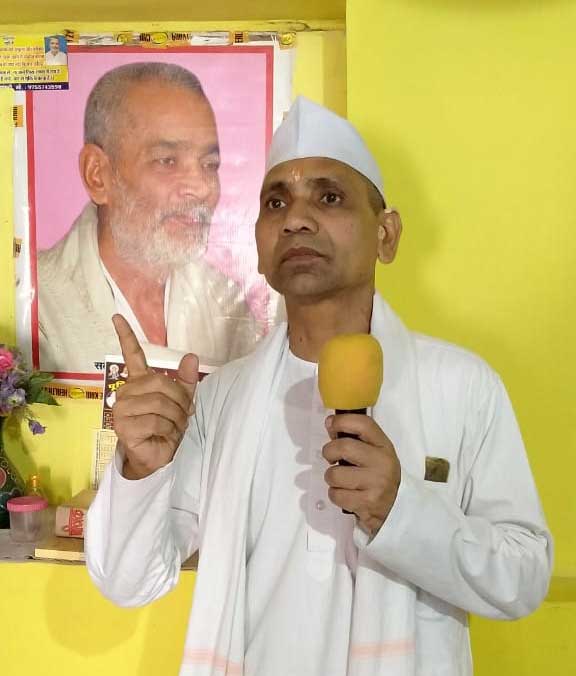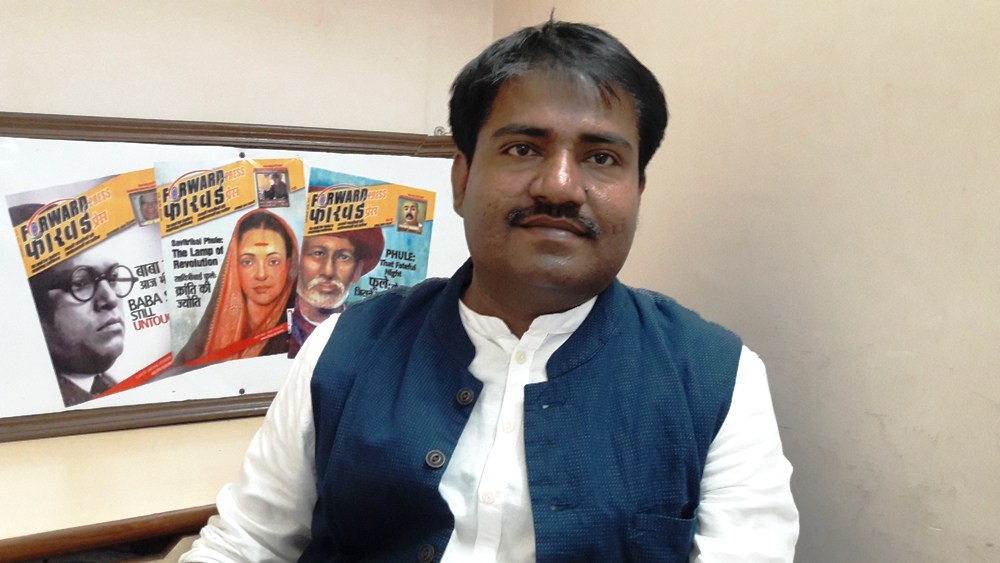Risal Saheb is the head of the Kabir Ashram in Dondekala, near Chhattisgarh’s capital Raipur, and a Panth Pracharak. He spoke with the Nawal Kishore Kumar about Satnamipanth and Kabirpanth. Edited excerpts from the conversation:
What is common between Kabirpanth and Satnamipanth?
Kabir Saheb and Guru Ghasidas both were worshippers of truth. This is common between the two. Meaning, whether it is a pauper or a king, a beggar or a millionaire or a billionaire – say the truth to his face, say it bluntly. This was what guided Kabir and this was what guided Guru Ghasidas. That’s why Guru Ghasidas said:
Satyanam ko sumrike tari gaye patit anek,
Tante kabhu na chhodiye, yahi satguru ka tek.
Satyanam hai saar, sumiro sant vivek kari,
Toh utro bhav jal paar, satguru ke updesh yah.
This is Satnam.
What are the similarities between the traditions of Kabirpanth and Satnamipanth?
You see, there are three main things: “roodhta”, “moodhta” and “goodhta”. Satguru Kabir Saheb did not follow any tradition. And he never looked back to see who was following him. He used to say, “Jo ghar jaare aapna, chale hamare sath.”
Kabir teri jhopdi galkatiyan ke pas
Jo karega so bharega tu kyon hot udas
…
Kabira khada bazaar mein liye lukati hath
Jo ghar jaare apna chale hamare sath.
Thus, the tradition of Satguru Kabir Saheb is not to follow any tradition blindly. He used to say:
Ved kiteb kaho kin jhootha, jhootha jo na vichare
In the pursuit of truth, he did not spare even the Vedas and the Quran. Whether it is the Vedas or Quran, they do contain the truth. But they contain some untruths, too. So “kar vandagi vivek ka, bhed gaye sab koy” – respect the reasoning power granted to you by the Almighty. Whatever anyone else might say, do what your reasoning power tells you to. First, understand what “roodhta”, “moodhta” and “goodhta” mean. Moodtha is accepting whatever anyone tells you as true without giving it a thought. Roodhta is doing whatever asks you to do without giving it a thought. As for Goodhta, it is something that can be understood only by imbibing it, by making it a part of your conscience. Kabir Saheb’s and Guru Ghasidas’ vanis are goodh vaanis. They are true vanis and they are scientific vanis. Not even an iota of what Kabir had said 550 years ago can be rejected on the basis of science because what he said was scientific. But if someone is presenting his own vani by labelling it as the vani of Kabir or of Guru Ghasidas, and is challenging science, then you can conclude that it is not the vani of Kabir or Guru Ghasidas.
So, in terms of ideology, there is no difference between Kabirpanth and Satnamipanth?
Yes. There is none. See, the words we use for them: Guru Ghasidas and Satguru Kabir. The word ‘Guru’ is prefixed to both the names. Satguru Kabir is embodiment of truth, he speaks the truth. Guru Ghasidas also speaks the truth. None of them bowed to anyone. So, there are similarities between Satnamipanth and Kabirpanth.
Can we say that the Satnamipanth is just a form of Kabirpanth?
Yes, absolutely. Guru Ghasidas was born about 200 years ago. And this year we celebrated the 625th birth anniversary of Satguru Kabir Saheb, who was born in the year 1398. So, Guru Ghasidas was influenced by Kabir. For instance, take Goswami Tulsidas ji. He was born about 100 years after Kabir. We can see Kabir’s influence on Goswami ji, too. The word “saheb”[1] in the Ramcharitmanas – Tulsi has taken it from Kabir. Similarly, there is Guru Nanak ji.
Tulsidas adopted the literary style of Kabir but he did not adopt his thinking. Do you agree?
Yes. He (Tulsidas) did not use Kabir’s thinking. At the time there was so much fanaticism among both Hindus and the Muslims that the speaker of truth was persecuted. You see, all great men, wherever they may have been born in the world, were persecuted when they dared to say the truth. Some were poisoned. But Kabir Saheb did what he said, he practised what he preached. Guru Ghasidas ji was also harassed. He was taunted with the “Untouchable” label. The pandits used to think highly of themselves. But Satguru Kabir Saheb spoke the truth. He spoke the bitter truth. His Vani could make you fret and fume. He said this to the pandit’s face:
Pothi padhi-padhi jag mua, pandit bhaya na koya
Dhayee aakhar prem ka, padhai so pandit hoya
How does Satnamipanth connect with Adivasi tradition?
It does not. I don’t think there is any connection. Their customs and beliefs are different. Satnamipanth and Kabirpanth both believe in a worshipping consciousness. There is no place for inert things in them. Both negate idol worship. But the Adivasis are different.

People from different castes have joined Satnamipanth. They include both the Dalits and the OBCs. Tell us about them.
As Kabir says:
Nana panth jagat mein nij-nij gun gavein
Apne ko saar bata sadmarag lavein
There are members of many castes among the Kabirpanthis. There are Sahus, Satnamis, Kurmis, Kevats, Yadavs and Chandrakars. It is said:
Dese-dese mein phira gaon gali ka khor
Aisa jiyra na mila jo levein phatak pachhor
Satguru Kabir Saheb was not stationed in one place. He was always on the move. To convey the truth, to convey knowledge, he went to the smallest of places, to the narrowest of lanes. And wherever he went, he spoke in the language of that place. In his quest for truth, he rose above caste, creed and sect.
Tell us something about the murder of Guru Balak ji, the guru of Satnamipanth in 1860.
(After some hesitation) Balak Das was not murdered in 1860.
It is said that Guru Balak Das was murdered to usurp the headship of the panth and that since then, a particular set of people have held onto that position.
Listen, my dear sir. “Mere panth khaare ka dhara, jo chale so utre paara”. Whosoever treads the path of truth walks on the thin edge of a sword. Whosoever speaks truth to society is persecuted, harassed. Guru Balak Das ji was probably also persecuted. He might have become a victim. Kabir called a spade and spade and look, how he was victimized … Sheikh Taqi, the guru of Sikandar Lodi, targeted him on 52 different occasions but he always emerged unscathed. Kabir did not spare the Mullahs either:
Kaankar paathar jodke, masjid liyo banay
Ta chadhi mulla baag de, kya bahra hua khuday
At the time, the Muslims were the unchallenged rulers of India. Kabir goes to a mosque and says “Kaankar paathar jodke, masjid liyo banay, Ta chadhi mulla baag de, kya bahra hua khuday”. Is your god deaf that you are shouting at the top of your voice? Today, Muslims are in a minority. But can anyone go to a mosque and say this today? He is sure to be beheaded. So, Kabir Saheb was like that. Guru Ghasidas was influenced by Kabir Saheb and that was why, he, too, had to face persecution.
But even now there is a dispute over the position of Guru. Why?
They do not understand Kabir Saheb and Guru Ghasidas ji. They declare themselves as the religious head of the panth of Guru Ghasidas. They claim that they head the Kabirpanth. But these people don’t have Kabir Vani in their heart. Kabir Saheb has used the word “das” (slave) so many times – “Rovain das Kabira hoye”, meaning he considered himself a slave. He called himself the son of a weaver. He was so humble. But the religious leaders of his panth, they sometimes call themselves Panthri, sometimes Huzur, sometimes Ek Sau Aaath, Ek Hazar Aaath and so on. They are conferring all sorts of titles on themselves. These people don’t understand Kabir Saheb and Guru Ghasidas ji.
Who are these people who want to capture the position of Guru? Are they upper-caste?
They serve their vested interests, running their businesses in the name of Kabir and Guru Ghasidas. They have abandoned Kabir. They present their own thinking as that of Kabir.
But don’t you think this is hurting Satnamipanth?
It is, definitely. Look at the Satnami community … how many times have I asked the leaders of the Satnami community in our village to celebrate the birth anniversary of such a great explorer of truth, Guru Ghasidas ji! And what do they do? They spend Rs 25-50 thousand and stage a play or a skit. Why don’t you invite an explorer of truth and ask him to give an hour-long lecture. I tell them this every year. But they continue to hold the same old path. And they use the Guru Ghasidas label. Ghasidas ji never said that they should do this.
Another distortion has been creeping into Satnam Panth. Characters of Hindu myths are being smuggled into panthi songs and dance.
You see, Guru Ghasidas ji shared his teachings with the help of panthi songs and dance. This continued in the same form for about 100 years. Subsequently, distortions crept into panthi songs and dance. Similarly, Kabir Saheb’s vanis have also become adulterated with time. What Kabir Saheb said in his Vani continued to be publicized and people did adhere to his teachings but with time, distortions crept in. This is what usually happens. And the same happened with Satnami Panth.
Whom do you blame for this? After Guru Ghasidas’ death, his teachings were documented. This was not possible during Kabir’s time. But during Guru Ghasidas’ time, this could have been done. Then, how did such a situation arise?
“Samrath ko nahin dosh gosayeen”. Can we blame Satguru Kabir or Guru Ghasidas for what has happened? We are the adherents, not those who have become religious leaders. These religious leaders are to be blamed because Kabir is saying one thing and they are saying something else. That is why distortions are creeping in.
The people associated with the Satnamipanth are being drawn to Hinduism. How do you view this?
It is like this. If a Satnami or a Kabirpanthi goes abroad, he won’t introduce himself as a Satnami or as a Kabirpanthi. He will introduce himself as an Indian. If a Muslim goes abroad, he won’t say he is a Muslim; he will say he is an Indian. Those who inhabited the banks of the Sindhu were called Hindus. It is a Farsi word. In Farsi, “sa” is pronounced as “ha”. So, Sindhu became Hindu. That is how the word “Hindustan” came to be coined. So, Hindu is not a word denoting a specific religion. Whosoever lives in Hindustan is a Hindu, no matter what his religion or sect is.
Let me rephrase my question. Are Satnamis being drawn to Sanatan rituals?
What Satguru Kabir Saheb and Guru Ghasidas ji didn’t even touch all their lives, which they negated all their life while continuing to explore the truth, today we are now adopting them as rituals. We perform “Chauka Aarti”. Now Chauka Aarti is also a ritual. That is happening with the Satnamis, too. You see, whether it is water or humans, they tend to flow downwards. If you have to lift water up, you have to use a pump. Similarly, to raise your consciousness you need satsang (association with the right people), swadhyay (self-study) and sadhna (industriousness). All these three things are lacking in today’s society. That is why the people are being drawn to rituals. That is happening everywhere. Brahmanism is ruling the roost. Everyone is trying to serve their own interests.
So, this is all about serving vested interests?
Everyone is serving their own interests. They are running their businesses. If I correctly convey what Kabir said or what Guru Ghasidas preached, then my business will suffer. That is what their mindset is and that is why they have abandoned Kabir Saheb and Guru Ghasidas.
How can the Satnami community expand?
No matter whom it hurts, we should adhere to what Kabir said 500 years ago and Guru Ghasidas said 200 years ago. Only then can society grow.
[1] Nigam Agam Saheb Sugam, Ram Sanchili Chaha
Andu Asan Avalokiat, Sulabh Sabai Jag Maha
(From Tulsidas, ‘Dohawali’, Gitapress, Gorakhpur, p 36)
(Translated from the original Hindi by Amrish Herdenia)
Forward Press also publishes books on Bahujan issues. Forward Press Books sheds light on the widespread problems as well as the finer aspects of Bahujan (Dalit, OBC, Adivasi, Nomadic, Pasmanda) society, culture, literature and politics. Contact us for a list of FP Books’ titles and to order. Mobile: +917827427311, Email: info@forwardmagazine.in)





